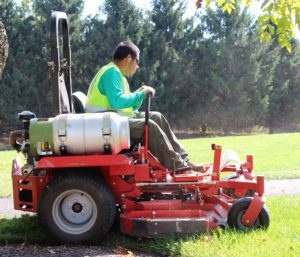By Dave Sanders, Safety and Loss Prevention Manager
 Mower accidents result in more than 55,000 injuries annually and some 75 people die from their injuries, according to the American Orthopedic and Foot Society. A large portion of the injuries involves loss of toes or part of the foot. Most mower accidents occur on slopes when the ground is damp or there is poor visibility. Use these tips to ensure that you and your team members remain as safe as possible when operating a mower:
Mower accidents result in more than 55,000 injuries annually and some 75 people die from their injuries, according to the American Orthopedic and Foot Society. A large portion of the injuries involves loss of toes or part of the foot. Most mower accidents occur on slopes when the ground is damp or there is poor visibility. Use these tips to ensure that you and your team members remain as safe as possible when operating a mower:
Before Beginning:
- Make sure that the mower is in good operating order and that you have read the operator manual and are familiar with the safety decals
- Ensure that all safety switches and operator presence controls are in proper working order and that the discharge chute is in the closed position
- Choose the right size and type of mower for the situation and determine if conditions are amenable to riding a velke
- Scout the site and remove objects that may become projectiles

Before operating a mower, put on the required personal protection equipment (PPE)—safety glasses, gloves, heavy rubber-soled boots, ear protection and safety vest.
While Operating:
- Fasten seat belt to ensure that operator stays put within the protected area should a rollover occur.
- Don’t operate on slopes greater than manufacturers’ recommendations and stay off wet slopes.
- Don’t get close to water, retaining walls or drop-offs and stay clear of autos and other objects.
- Watch for pedestrians/team members/site visitors and stop operating the mower if anyone gets near.
While we all want to be efficient and meet our production schedules, it’s important to be regimented and not cut corners when it comes to safety. The best rule of thumb for mowing safely is that if it looks unsafe, it probably is. So as we head into a busy mowing season, please do your part to keep us safe!